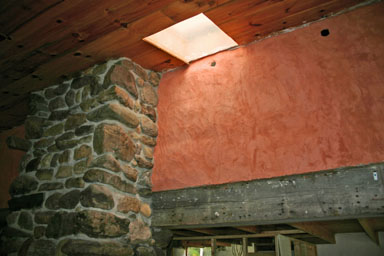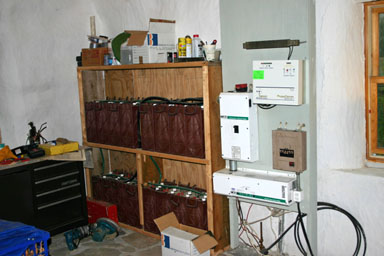October 3, 2004
Visiting a strawbale house
Several houses in Tompkins County were part of the Northeast Sustainable Energy Association's 2004 Green Buildings Open House. I didn't make it to the Tompkins County SPCA, which is usually more accessible than private houses, but I did get to visit two houses with solar and other energy-efficient features.
The first, on Ellis Hollow Road in Caroline, used solar panels and geothermal heating and cooling in a house of energy-efficient but otherwise relatively typical modern construction and design. Its solar panels powered the house and fed energy back to the electrical grid. The second, on Bone Plain Road in Dryden, was a more decisive break from ordinary construction, relying on solar and wind power and remaining entirely off the electrical grid.

A crowd of visitors explores the strawbale house at Earthwalk Farm.
The home's owners and builders, Lynn and Suzanne McMannis, graciously answered all kinds of questions about the house, which is a work in progress. The house is built on a shallow frost-protected foundation, a design learned from Scandinavian construction. The floors are mostly stone collected from convenently piled hedgerows, though the kitchen will eventually have oak flooring. A massive stone chimney rests in the middle of the house. The walls are post-and-beam with strawbales filling the walls, giving it R-45 insulation. The most visible beam was salvaged from an Enfield barn, and the straw is local, one-quarter of it coming from their own property.

Chimney, wall, and beam at Earthwalk Farm.
A 600-pound woodstove used for both cooking and heating is at the center of the house. Most of the energy for the house comes in at its southwest corner, where the power from the six 120-watt solar panels and (84-foot tall) 1000 watt wind turbine come into regulators and a battery bank.

Power storage and management at Earthwalk Farm.
The McMannis's have a 50-acre parcel complete with orchards, gardens, a woodlot, and pasture. They built a barn before building the house. Lynn McMannis made clear that his interest in building this way was political - he and his wife Suzanne had managed to reach a $25/month electrical bill in a more conventional house, but wanted to get entirely off the grid. They've paid for everything in cash, reinforcing the message that they're doing this for independence.
I asked what experience they'd had with building codes during construction, and Lynn said that they'd found the Dryden code enforcement officer, Kevin Ezell, helpful and interested. They'd been ready to make a strong case about why such a non-standard building should be granted an exemption from the usual expectations, only to find Ezell interested in seeing how the experiment would work out.
They have had a few problems. The power inverter, which converts the 24V DC coming from the battery bank to 120V AC, went down at one point and needed replacement, at a time when their largest AC appliance was the refrigerator. After delays in getting it repaired, they eventually bought a DC refrigerator and freezer. They're making as much of the house as they can run on the DC power directly rather than wasting 8% of their power in the conversion from DC to AC.
McMannis had some advice for those who want to build their own homes, noting that "a homesteader's best friend is a 5-gallon bucket," and pointing out how their choice of foundation had spared them major excavations. They've generally tried to use local materials and "eschew loud machines", but have compromised when it made sense - some plywood, insulation, appliances, and other pieces aren't all natural, and there were a number of power tools around.
I've posted a gallery of pictures if you'd like to see more of this fascinating home-in-progress.
Posted by simon at October 3, 2004 12:07 AM in West Dryden , energyNote on photos